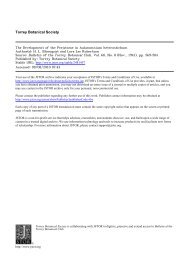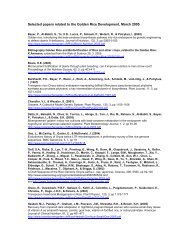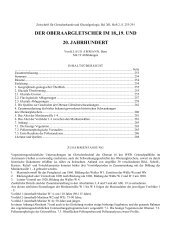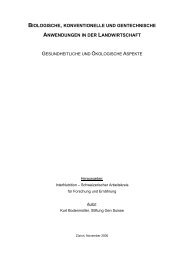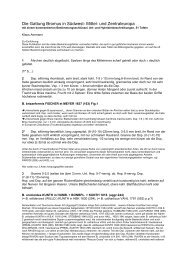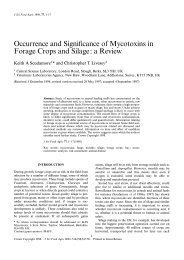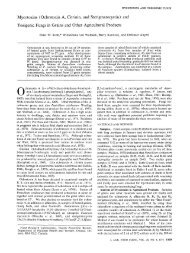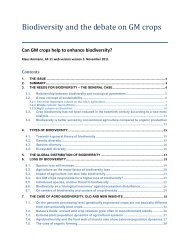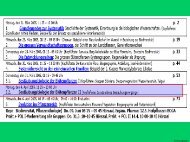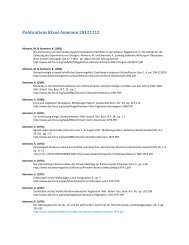Genetic engineering of plants to enhance resistance to fungal ...
Genetic engineering of plants to enhance resistance to fungal ...
Genetic engineering of plants to enhance resistance to fungal ...
You also want an ePaper? Increase the reach of your titles
YUMPU automatically turns print PDFs into web optimized ePapers that Google loves.
Punja: genetic <strong>engineering</strong> / <strong>fungal</strong> disease <strong>resistance</strong> 223<br />
Table 1 (concluded).<br />
Strategy used and plant species<br />
engineered Expressed gene product Effect on disease development Reference<br />
Cot<strong>to</strong>n (Gossypium hirsutum L.),<br />
<strong>to</strong>bacco (N. tabacum)<br />
Pota<strong>to</strong> (S. tuberosum)<br />
Tobacco (N. tabacum), A. thaliana<br />
Tobacco (N. tabacum)<br />
Talaromyces flavus<br />
glucose oxidase<br />
Aspergillus niger<br />
glucose oxidase<br />
Tobacco catalase<br />
Bacterial salicylate<br />
hydroxylase<br />
Bacterial salicylate<br />
hydroxylase<br />
Bacterial enzymes generating<br />
salicylic acid<br />
Arabidopsis ethyleneinsensitivity<br />
gene<br />
Phy<strong>to</strong>phthora cryp<strong>to</strong>gea<br />
elici<strong>to</strong>r (β-cryp<strong>to</strong>gein)<br />
Phy<strong>to</strong>phthora cryp<strong>to</strong>gea<br />
elici<strong>to</strong>r (cryp<strong>to</strong>gein)<br />
Expression <strong>of</strong> combined gene products<br />
Carrot (D. carota) Tobacco chitinase + β-<br />
1,3-glucanase,<br />
osmotin<br />
Tobacco (N. tabacum) Barley chitinase + β-<br />
1,3-glucanase, or<br />
chitinase + RIP<br />
Rice chitinase + alfalfa<br />
glucanase<br />
Toma<strong>to</strong> (L. esculentum) Tobacco chitinase + β-<br />
1,3-glucanase<br />
Enhanced protection against Rhizoc<strong>to</strong>nia Murray et al. (1999)<br />
solani and Verticillium dahliae; no<br />
effect on Fusarium oxysporum<br />
Delayed lesion development due <strong>to</strong> Phy<strong>to</strong>phthora<br />
infestans; reduced disease<br />
Wu et al. (1995, 1997)<br />
development due <strong>to</strong> Alternaria solani<br />
and Verticillium dahliae<br />
Reduced lesion size due <strong>to</strong> Phy<strong>to</strong>phthora Yu et al. (1999)<br />
infestans<br />
No effect on Phy<strong>to</strong>phthora infestans Yu et al. (1997)<br />
Enhanced susceptibility <strong>to</strong> Phy<strong>to</strong>phthora<br />
parasitica, Cercospora nicotianae, and<br />
Peronospora parasitica<br />
Enhanced <strong>resistance</strong> <strong>to</strong> Oidium<br />
lycopersicon<br />
Enhanced susceptibility <strong>to</strong> Pythium<br />
sylvaticum<br />
Reduced infection by Phy<strong>to</strong>phthora<br />
parasitica<br />
Enhanced <strong>resistance</strong> <strong>to</strong> Phy<strong>to</strong>phthora<br />
parasitica, Thielaviopsis basicola, Botrytis<br />
cinerea, and Erysiphe cichoracearum<br />
Enhanced <strong>resistance</strong> <strong>to</strong> Alternaria dauci,<br />
Alternaria radicina, Cercospora<br />
carotae, and Erysiphe heraclei<br />
Reduced disease severity due <strong>to</strong><br />
Rhizoc<strong>to</strong>nia solani<br />
Reduced rate <strong>of</strong> lesion development and<br />
fewer lesions due <strong>to</strong> Cercospora<br />
nicotianae<br />
Reduced disease severity due <strong>to</strong><br />
Fusarium oxysporum f. sp. lycopersici<br />
Note: dsRNA, double-stranded RNA; RIP, ribosome-inactivating protein; TLP, thaumatin-like protein.<br />
Delaney et al. (1994);<br />
Don<strong>of</strong>rio and Delaney<br />
(2001)<br />
Verberne et al. (2000)<br />
Knoester et al. (1998)<br />
Tepfer et al. (1998)<br />
Keller et al. (1999)<br />
Melchers and Stuiver<br />
(2000)<br />
Jach et al. (1995)<br />
Zhu et al. (1994)<br />
Jongedijk et al. (1995); Van<br />
den Elzen et al. (1993)<br />
1993; Jach et al. 1995; Shah 1997; Evans and Greenland<br />
1998; Salmeron and Vernooij 1998; Melchers and Stuiver<br />
2000).<br />
Pathogenesis-related proteins<br />
Other PR proteins that exhibit anti<strong>fungal</strong> activity, including<br />
osmotin- and thaumatin-like proteins (TLP), and some<br />
uncharacterized PR proteins have been engineered in<strong>to</strong> crop<br />
<strong>plants</strong> (Table 1). Osmotin is a basic 24-kDa protein belonging<br />
<strong>to</strong> the PR-5 family whose members have a high degree<br />
<strong>of</strong> homology <strong>to</strong> the sweet-tasting protein thaumatin from<br />
Thauma<strong>to</strong>coccus danielli and are produced in <strong>plants</strong> under<br />
different stress conditions (Zhu et al. 1995). The PR-5 proteins<br />
induce <strong>fungal</strong> cell leakiness, presumably through a<br />
specific interaction with the plasma membrane that results<br />
in the formation <strong>of</strong> transmembrane pores (Kitajima and<br />
Sa<strong>to</strong> 1999). Osmotin has been shown <strong>to</strong> have anti<strong>fungal</strong> activity<br />
in vitro (Woloshuk et al. 1991; Melchers et al. 1993;<br />
Liu et al. 1994) and, when tested in combination with<br />
chitinase and β-1,3-glucanase, showed <strong>enhance</strong>d lytic<br />
activity (Lori<strong>to</strong> et al. 1996). When expressed in transgenic<br />
pota<strong>to</strong>, osmotin was shown <strong>to</strong> delay expression <strong>of</strong> disease<br />
symp<strong>to</strong>ms caused by Phy<strong>to</strong>phthora infestans (Table 1).<br />
Thaumatin-like proteins are also expressed in <strong>plants</strong> in response<br />
<strong>to</strong> a range <strong>of</strong> stress conditions and were demonstrated<br />
<strong>to</strong> have anti<strong>fungal</strong> activity in vitro (Malehorn et al.<br />
1994; Koiwa et al. 1997). Expression <strong>of</strong> TLP in transgenic<br />
<strong>plants</strong> was reported <strong>to</strong> delay disease development due <strong>to</strong> several<br />
pathogens, including Botrytis, Fusarium, Rhizoc<strong>to</strong>nia,<br />
and Sclerotinia (Table 1). Combinations <strong>of</strong> PR-5 protein expression<br />
with chitinases or glucanases in transgenic <strong>plants</strong><br />
have not been reported and it is anticipated that the level <strong>of</strong><br />
disease reduction achieved would be significantly higher.<br />
Antimicrobial proteins, peptides, and other<br />
compounds<br />
Defensins and thionins are low molecular mass (around<br />
5 kDa) cysteine-rich peptides (45–54 amino acids in length)



